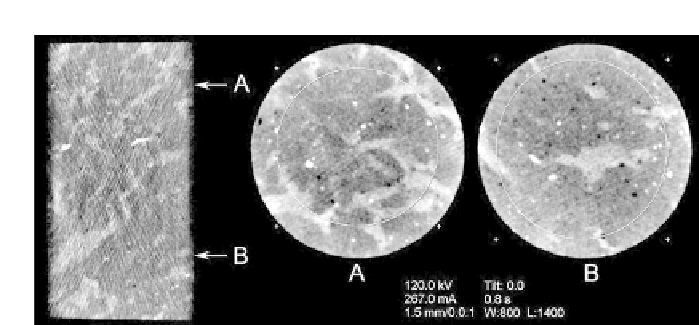Environmental Engineering Reference
In-Depth Information
FIGURE 6
CAT-scan of a borehole core (
11 cm in diameter) from a Campanian deep-sea fan
system of the Vøring Basin, Norwegian Sea (cf.
Knaust, 2009a
). The axial and accompanying cross
sections reveal a complex burrow system with meniscate backfill cf.
Ophiomorpha
isp., which is
difficult to recognize in the two-dimensional expression of the slabbed core (see
Fig. 8
).
examine trace fossils in core (
Fu et al., 1994; Gerard and Bromley, 2008
;
Fig. 6
),
and in the investigation of morphological features of burrows and macro- and
microborings (
Capowiez et al., 2003; Sch¨nberg and Shields, 2008
).
Gingras
et al. (2002a)
and
Pemberton and Gingras (2005)
used magnetic resonance
imaging for the visualization of complex burrow systems and related porosity.
3.7 Polymer-Resin Casting
Casting of microborings in carbonate substrate is a standard procedure in ich-
nology in order to perform SEM studies on the morphology of these tiny traces
(
Golubic et al., 1975; Wisshak, 2012
). After cleaning the open boring systems
with hydrogen peroxide and in an ultrasonic bath, the samples are infiltrated
with low-viscosity epoxy resin in a vacuum chamber (
Nielsen and Maiboe,
2000
). The solid resin block can then be cut and the carbonate substrate etched
using a dilute acid. The nicely exposed casts are then ready for coating with
metal and examination with SEM.
4. BOREHOLE CORES AND IMAGES
4.1 Well Cores
Well cores are an invaluable source for ichnological and sedimentological
information from the subsurface and are usually obtained during the exploration
of hydrocarbon, aquifers, and deep-sea drilling programs. The limited size,
restricted surface, two-dimensional expression on (often vertical) core slabs,
etc., require a special treatment of ichnological data in well cores. The acquired
core can either be studied as full core or, more commonly, as individual slabbed
sections such as the half-cut or a slabbed and resinated slice from the middle
(
Blackbourn, 2009
;
Fig. 7
A). Because of the economic value, the procedure
of studying trace fossils in core has received much attention in numerous






Search WWH ::

Custom Search